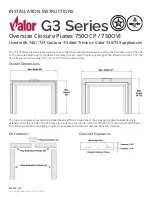
© EUROHEAT DISTRIBUTORS (H.B.S) LTD. October 2012
E & OE Instructions Part number IN1264 Edition A
11
Housing Construction, without an Existing Chimney Breast
If the property has no existing chimney or chimney breast the first consideration will be the positioning of the
flue. Taking the flue to the roof internally through the property will involve complying with many regulations
and even an external flue may be subject to planning regulations. Because there will be no existing structural
hearth, this will need to be constructed following the strict Building Regulation requirements. For these reasons
we cannot recommend that anyone without the necessary experience constructs the housing and flue system for
a multifuel insert stove.
Insulation
Steel support
Lintel
Insulating board
Insulating blocks
Because the temperatures reached by the stove’s top and side panels may reach over three hundred degrees
Celsius all materials used for constructing the housing must be both non-combustible, stable at high temperatures
and insulate any part of the building which may be affected by heat. It should be borne in mind that insulating
materials only limit the rate of heat transference from the heated surface to the unheated surface and if the
dispersal of heat from the unheated surface is less than the rate of heat transference the entire body of insulating
material will reach an almost uniform temperature.
The insulating properties of many modern houses are extremely high and many external walls are now constructed
with an inner skin of plasterboard, supported on a wooden frame which is thermally insulated from the outer
skin of brick. Having such a low thermal conductivity makes it impossible to use the outer wall as the back of the
stove’s housing unless a means of ensuring that non of the heat from the stove is transferred to the house wall.
Whilst this may sound daunting the reward will be a vast increase in heating efficiency.






































